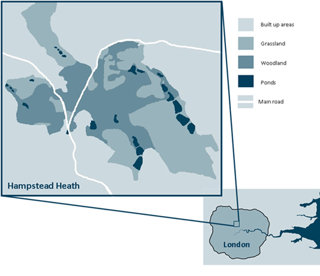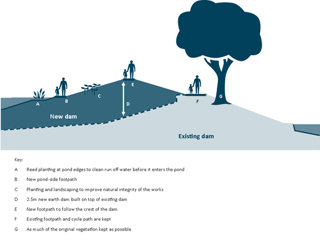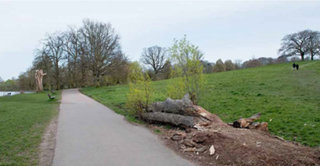April 2015
What and where are Hampstead Heath Ponds?
Hampstead Heath is a 3.2km2 open space found largely in the North London boroughs of Camden and Barnet. Since 1989 it has been managed by the City of London Corporation as a public open space. The Heath combines a variety of different landscape types, such as open grassland, heath, woodlands, hills and marshes, with extensive human use through open air swimming in some of the ponds and play areas for children as well as extensive networks of walking paths. The Heath is also a refuge for a variety of wildlife, with many species of birds, mammals, amphibians and invertebrates calling it home.

The location of Hampstead Heath
Originally, some of the ponds, which number over thirty, were dug in order to provide and secure drinking water for the local population by storing water from the River Fleet that flowed from the Heath to Blackfriars where it met the River Thames, but which is now subterranean. With the development of more advanced piped water through London, the ponds were no longer needed for this purpose and became recreational sites.
What is the Hampstead Heath Ponds Project?
Due to their size, three of the ponds are large enough to be classified as reservoirs under the 1975 Reservoirs Act and this means that specific legislation applies to their management. Experts’ interpretation of this legislation states that the City of London Corporation have to make the ponds’ earth dams safer to prevent them from being breached in an extreme rain event – an important consideration given that there is currently a four percent chance that overtopping will occur in a single year. Improvements to the dams would ensure that the City of London Corporation remains able to minimise damage to life, property, and transport networks in the area.
Why has the Project caused so much controversy?
The City of London Corporation has a duty of care towards the Heath and its ponds through the 1871 Hampstead Heath Act. This means that changes to the earth dams cannot be made without also considering the impact any changes would have on every other part of the Heath, including how members of the public are able to access and use the ponds. The Heath is extremely popular with both local residents and with people from further afield (an estimated 7.2 million visits to the Heath are made every year) and represents a very well loved piece of the capital.
Many people who have an interest in the future of the Heath have shown concern about the impact any changes might have on wildlife as well as the level of disruption to the human use of the Heath that might come about as a result of the works themselves. (For further information on local opposition to this project please see the reports in the local High and Ham newspaper.
What is happening to the ponds?
In order to comply with both the 1975 Reservoir Act and the 1871 Hampstead Heath Act, the City of London Corporation has had to plan the works extremely carefully. In the end, they saw the works as an opportunity to make some substantial enhancements to the Heath and the ponds, while meeting the requirements that were needed to satisfy the foci of the legislative acts.
The earthen banks that hold the water in the linked sets of ponds are not what one might normally think of as dams, but their structure and composition make them far easier to alter than formations made with more unnatural materials. The individual plan of works to the ponds, their dams and the landscaping around them is extensive, with work taking place in 12 locations over 18 months (starting in spring 2015) which the City of London Corporation propose it will take for the works to be completed. In particular, the Model Boating Pond, in the centre of the more easterly Highgate chain of ponds, will see a greater concentration of the works as its size and position make it more resilient to changes than the ponds with more environment sensitivity. It is also the least natural of the ponds and the City of London Corporation has been keen to ‘soften’ the look and feel of this pond; allowing it to better fit amongst its surrounding.
The dam here will be raised by two and a half metres, with new, water friendly vegetation being planted along its edges and new footpaths being placed both at pond side and on the top of the dam. On the edges of many of the other ponds, grass-covered spill ways will be landscaped into place to allow excess water to move from one pond to the next without causing damage to the earth dam and at the same time not prevent people who use the Heath from continuing to do so.

The new design features of the Model Boating Pond looking east
(Source: Interpretation from City of London Corporation)
At the Catchpit Valley, in the more westerly Hampstead chain of ponds, a new 5.6m high grass embankment will be created, forming a dry dam. For the most part this will be obscured by the woodland already in place there.
What impact will the Project have environmentally?
The Project has been designed with minimal tree removal at the heart of its plans and while it is inevitable that some vegetation will be lost due to the works, new planting has also been included to counterbalance this. The installation of reed beds will act as new habitat zone for birds, amphibians and invertebrates and the total increase in wetland habitats across the whole Heath will provide greater space for aquatic ecosystems to become more viable. The reed beds will also act as natural filtration systems for the pollutants that make their way into the ponds, cleaning the water and enhancing the quality of the freshwater environment.
The new dams have been designed to be in keeping with the natural landscape and to continue to use the same materials such as earth and clay as when they were first built. Artists’ impressions of the dams and the changes they make to the size of the ponds show that although in some cases there are some dramatic changes, if done sensitively, the Project should not detract from the natural feel of the Heath.

Model Boating Pond looking south after works completed
(Source: City of London Corporation)
What impact will the Project have socially?
The raised paths around the Heath are thought to not only enhance the views available to walkers but increase the ways they can enjoy the ponds. The water in the ponds is likely to be cleaner, making it safer and more attractive to people who use them for swimming – over 750,000 visits are made to the bathing ponds for this purpose every year. In the eighteen months in which the works are scheduled, every effort has been made to keep as much of the Heath open as possible, though inevitably some ponds will be closed to swimming as works are completed.
More than anything else, the Project is designed to make the Heath and the surrounding residential areas less prone to flooding and with this at its core, one might think of the other social impacts simply as additional advantages. Though the last time the Heath and the surrounding area experienced a major flood was in 1975, the ponds have overtopped as recently as 2010. Despite this, many residents are unconvinced of the need for higher levels of defence. On the other hand, with many people in the area living in basement flats, even a minor flood could have far reaching consequences financially and without such defence, insurance costs against flooding will rise.
What impact will the Project have economically?
The whole Project is estimated to cost around £21 million. This cost has been covered by the City of London Corporation, independent of local authority funding. Some local commentators have suggested that the improvements to the ponds may cause a small increase in local house prices, while others recognise that because of the specialist nature of the Project, few local people will be employed in the work itself; it instead being put to out to tender to those able to complete the project to time and monetary budgets.
Key Words
Common Land
Land that is open to the public for their use and often has a shared ownership between them.
Dam
A barrier that holds back water within an aquatic system, often for the purpose of hydroelectric power generation and flood control.
Ecosystem
A set of living organisms that interact with non-living components to create a system of inputs, processes and outputs.
Reservoir
A body of water that pools as a result of the placement of a dam.
Lesson Ideas
Students can annotate a map of the Hampstead area using impact evidence from the 1975 floods on the Heath. This can then feed into a discussion about the size of the risk to residents local to the Heath.
Using the Hampstead Heath Ponds Project website, students can choose one part of the proposed works and complete a conflict matrix associated which looks at which players and users in the scheme will be most in conflict with each other.
Imagining they are an ecologist working at the Hampstead Heath Ponds, students can design a piece of fieldwork which would aim to measure the Ponds’ biodiversity. Students can also discuss how they might use the data they collect and design risk assessments for the fieldwork.
File nameFiles
File type
Size
Download


